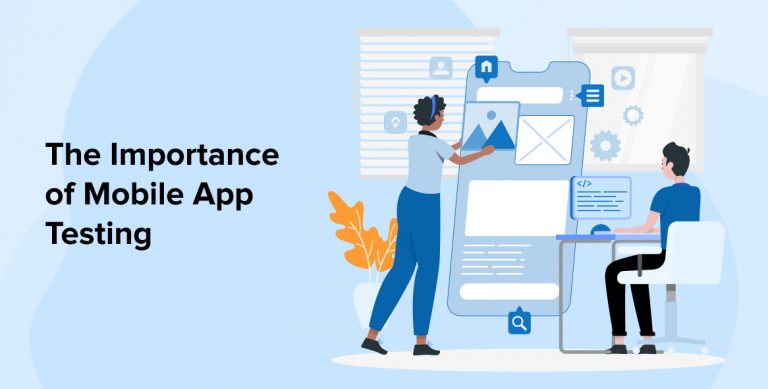Related Blogs

Mobile app testing has always been an inseparable part of software application development. It has visibly gained much attention and growth for businesses to reap benefits from it. Every business wants to make its way in the ever-growing digital world and stay ahead of the competition by developing unique applications. But the approach is different in each case.
It wouldn’t be incorrect to say that convenience is the key to customer success. Hence, mobile applications are in demand. But developing an app is not easy. The most common complaint that businesses receive from customers is that they are not handy, or easy, or that a mobile application could be prevented with complete mobile app testing before launch.
If we were to talk directly about the facts then here it goes
- 57% of all digital media usage comes from mobile apps.
- 21% of millennials open an app 50+ times per day.
- Mobile apps are expected to generate $189 billion in revenue by 2020.
- 90% of mobile time is spent on apps.
What exactly should we assume from these facts? It is a simple, easiest and faster way of communication are mobile phones and hence they should be up-to-date without errors. Thus, we must test mobile apps thoroughly so that they deliver the best results. Mobile testing has advanced and there are numerous testing tools available in the market that would deliver accurate results. Irrespective of Android and iOS, mobile testing
Each app must run flawlessly on thousands of different devices and operating systems. To ensure that this is possible, mobile testing must be planned and executed with the utmost thoroughness and accuracy. In this blog, we will be exploring the complete process of mobile testing to understand how it works, and what results it delivers.
1. Overview of Mobile Apps Market Scenario
Undoubtedly, we have seen that a smartphone has become an indispensable part of everybody’s life. Facts share the same story. Whether it is an individual or a corporate, the use of mobile applications has just grown. For most businesses, it is a necessity to have a mobile application or a website that shows how efficient the business is and what it can offer.
Moreover, there are many new businesses emerged which are based on the mobile app. Some of the most popular applications we regularly use are WhatsApp, Line, Snapchat, Games like Pokémon Go, Candy Crush, Wallet apps, or other popular apps like Flipboard, Pocket, Vine, Tinder, Uber, Prisma, and many others.
Now if we see the same in the year 2021, the mobile app market is continuously evolving. But with the increasing need, we need some better testing methods to get good results from Mobile apps. Interestingly, there are companies who are willing to participate in the growth of applications by investing a good sum and getting a higher return on investment. Research shows more than 79% of companies are investing in mobile app testing, and this count will just increase with time. So, will be the demand of mobile application developers for improving the overall business cycle.
2. Why Should Mobile Testing be Considered?
Enterprises are already in the mobile apps business, they are competing for the top place in app downloads. While a lot believe that the success of mobile apps depends on the kind of program and its capabilities, some of it does believe that the true differentiation between a mobile application that sells and one that does not is its performance. It is not just about having a cool app, users are likely to abandon a program if its functionality is problematic, regardless of how promising it may seem. On the contrary, even the simplest applications could be lucrative for a business if it works flawlessly.
Around half of the poor reviews on the app stores are based on concerns such as crashes, poor performance, and battery drain. It’s a fact that there’s no major software engineering field rifer with possible hazards other than mobile development.
Everyone has experienced a sudden surge of frustration which results in a deleted app. That is why mastering the art of mobile testing is increasingly growing in relevance for any organization that wants to stay competitive. The majority of software companies already recognized the value and relevance of investing in mobile app development. That is why it only makes sense to extend the investment to testing mobile apps. This will deliver more accurate and faster results.
Well, regardless of the added complexity and cost that programming and testing mobile for various mobile platforms entails. In the long run, the extra work involved in quality assurance surely pays off.
Step 1 – Choosing Type of Mobile Testing
Before deciding whether to test use cases manually or automatically, a developer should create a list of all the scenarios he intends to test. Create a test strategy for mobile apps that includes all the use cases you want to access, as well as a brief description of the tests you want to perform and the sprint’s expected outcome.
But before that, we must know, what are we looking at when we test a mobile application.
Mobile application testing is the practice of testing apps that are being created for mobile devices. The primary goal is to evaluate the programs’ functionality, usability, and stability. In today’s industry, mobile application testing is critical for an app’s survival. To ensure the highest possible quality for end-users, the program is additionally evaluated in a variety of other areas, including other parameters that must be checked for businesses to know how mobile apps work for them.
In a mobile application, there can be multiple types of glitches, there can be performance issues or functionality issues, or there can be multiple nonfunctional or functional challenges that obstruct applications to perform well. Thus, the first step in mobile app testing is to get the mobile app thoroughly tested to get high-performing results.
There are multiple ways you can perform mobile tests on applications, so let’s discuss the majority ones in brief
Step 2 – Types of Testing
“One size fits all”- this doesn’t apply in testing. Every product developed has a different need for mobile testing and every business has to fulfill it in some way. Thus, here are some of the top mobile testing types that are applied by the Top mobile testing companies. We will get into the specification of each type.
Usability Testing
Usability testing is one of the best ways to evaluate the simplicity of the application and how users can achieve their goals by offering easier usability. This test entails providing particular, realistic situations of app use to individual users. Usability testing is also reliable when it is based on direct input from the end-user.
Performance Testing
Performance testing is an important subset of mobile application testing that evaluates an application’s performance, stability, and responsiveness under certain workloads and circumstances. Furthermore, it also resolves performance constraints prior to launching an application. The performance bottlenecks inside the system and overall operations that impede or halt overall performance are taken care of during this type of testing.
Security Testing
Security is one of the prominent concerns of almost every mobile app owner at the present time. Reportedly, It is highly essential to focus on security testing for mobile apps. Certain applications require the personal information of users for different transactions. It is very important for users to know the security constraints and take the guarantee of confidentiality, integrity, and authenticity.
Compatibility Testing
Compatibility testing is a form of non-functional testing that verifies the functioning of a mobile app on various operating systems, apps, devices, particular internal hardware requirements, and network settings. It also checks a mobile app’s compatibility with various devices, browsers, networks, and other factors.
Localization Testing
Localization testing is a type of testing which tests certain local aspects as per certain geographic locations. It is critical to test the mobile app for responsiveness to unique linguistic and cultural elements of the affected location. Local currency, usage of correct time zone date and time formats, and other local regulations are some of the key areas that localization testing validates.
Functional Testing
As per the name, this sort of testing is primarily concerned with the core goal and flow of the mobile app. Functional testing services ensure that the functionalities of the mobile app fulfill the needed standards and are highly responsive. Functional testing also determines whether an application is capable and fully functional for users to get successfully launched and installed.
Unit Testing
In this type of testing, your whole application and program are divided into smaller units. There is a reason why businesses divide testing into units because It’s easy to identify, and the tests are resolved quickly. It takes less time to execute and test. The app will be seamless and smooth to work.
Manual Testing
It is one of the tried-and-true methods for completely traversing the complexities of mobile testing. Manual testing ensures that the finished product performs optimally in accordance with the desired expectations. It is especially useful in instances where the application is not immediately evident. QA testing specialists might work in short bursts to examine an application that could offer results.
Automation Testing
Certain mobile app quality checks, on the other hand, are overly complicated and time-consuming. In such circumstances, Mobile App Test Automation Services come into play, with optimally set and quickly conducted automated testing as well as human tests, which may aid in guaranteeing quality while also providing better products at a faster rate.
Step 3 – Preparing Test Cases for Different Test Scenarios
The next step in the process of software testing is to test each case. This has a different approach in different test cases. When you write a test case for testing mobile applications, it is no different. A test case is basically a series of test steps, test data, pre and post conditions to validate any specific test requirement. There is a difference between Test cases and Test scenarios. Test scenarios are an estimation of what it should include in the test case. The test case comprises particular variables or circumstances that a testing engineer may use to compare expected and actual outcomes to evaluate whether a software product is working according to the customer’s expectations.
The mobile test cases work the same for both ios and android. With the available mobile testing tools, the testing process becomes easier. Apart from mobile apps, you can also test web apps. In the preparation process of test cases, you can frequently structure them into test runs.
A test run is essentially a set of test cases that testers must complete in a specific order. Rather than adding pre-conditions into each test case, you might place them at the start of a test run. When you have a testing process in place, you can easily perform testing on real devices. There are web apps, mobile apps, and hybrid apps – all that can be tested easily and will improve the future of app performance.
Mobile Testing allows testing on real mobile devices by running test automation scripts and different platforms from windows, android, and ios. Other mobile testing areas and test scripts should ensure that apps work in sync with all functionalities and features in any mobile device of customers.
Step 4 – Mobile Application Testing Levels
We have already seen types of Mobile application testing. But do we exactly know at what level each of these testing methods should be implied? If you want to ensure the best quality, testing should take place throughout the development process. It should start at the beginning of the design phase and continue until the application is delivered to the application store. Post-delivery, after updates there can be challenges that need to be addressed, and hence Testing plays a major role at each stage. Let’s see which testing is implied at the initial level.
- The First Level in Test Mobile starts with the Designing Phase
Test the design of your mobile app to verify that it has the necessary functionality and ease of use to keep people interested. This covers anything from precise suggestions for button and font size to the usage of progress alerts, mobile app settings, and controls. A/B testing, which compares two designs, is a typical technique to improve the user experience and Quality of application design.
- The Next Level is to Integrate Third-party Apps using Integration Testing
Integration testing ensures that new code functions properly once it has been integrated into an application. When many developers work on the same project, integration testing ensures that their code modifications do not clash. Many mobile development teams use a continuous integration environment to make this process more efficient.
- The Next level is Functional/Non-Functional Testing
In the category of functional Testing, it determines if an application performs as expected, typically by comparing it to design documentation. It is used to inspect the user interface, including UI layouts and components, menu structure and functionalities, and the reaction to changes in screen orientation and resolution.
While in the category of Nonfunctional testing, it tests Operational testing, interrupt testing, security testing, and performance testing. It comprises various non-functional aspects of mobile apps such as app performance, battery use, Data consumption, low-level resource/memory usage/memory leakage, and more. This necessitates test scenarios that go to the outskirts of each instance to determine minimal and maximum utilization.
- The Last one is UAT -User Acceptance Testing
Acceptance testing verifies that a mobile application provides the functionality, usability, and performance to meet the user’s needs, and that it delivers a consistent user experience (UX) across platforms. An important part of acceptance testing is beta testing on real devices by real end-users. Managing beta testing in both iOS and Android can be done by the company you hire.
All of these are levels of testing which means, firstly we used testing in the design phase, the integration phase, then we can perform the functional and non-function tests, and finally perform Acceptance testing for all the errors of testing mobile applications.
Step – 5 Mobile Application Testing Strategy
Mobile application testing strategy that ensures Quality Assurance align with business goals, customer expectations, and industry best practices:
1. Selection of a Mobile App
With the selection, there are two choices, choosing a gadget model or choosing between substantial devices and emulators. Other factors like connectivity options, memory size, and more should be accounted for when choosing a device model.
2. Mobile testing on Cloud
Mobile testing that is cloud-based makes potentially infinite scenario combinations easier to manage. This is a desirable option for testing mobile apps. The cloud offers a web-based testing environment wherein apps could be deployed, tested, and managed.
3. Emulators vs. Physical Devices
One could also decide among emulators or physical devices. In the starting stages of development, device emulators are very useful since they help in fast and efficient testing, particularly in an agile development scenario. Physical device testing leads to beta testing as a very useful method that provides admittance to real devices, real-world testers, actual networks, and bigger geographic coverage.
4. Network Connectivity
This considerably affects mobile apps as the majority of mobile applications rely on network connectivity to function correctly. Testing mobile apps in actual network environments is critical to get the real picture of the behavior of an app.
5. Manual vs. Automated
The key to a successful regression is automation during the development stages. However, automated testing requires a large amount of initial investment.
3. Testing is the Answer to the Mobile App Concerns
Mobile testing is an answer to mobile woes and could help developers prevent the failure of a program. Nonetheless, knowing that testing mobile should take place and determine what to test are different things. It could be a challenge to find out the specific elements that need mobile testing as if any of these vital aspects are missed, the application could be erroneous. You need to test various areas, and different features under every category as well. Check out the below image of the mobile application testing checklist for details.
For instance, functionality testing must occur at the start. Functionality tests must include customer submission forms checks and the search feature. In addition, developers must check out media components like video and audio playback, compatibility of libraries and scripts, and any calculations or manipulations that the application could carry out.
For any business, making sure that the app is working correctly is paramount. The same care that an organization puts into the product concept and creating the business, should be put towards testing mobile and quality control of mobile apps. This kind of testing isn’t something that could be done in-house as it requires technical expertise.
Professional mobile application testing companies could help identify issues before prospective customers could face frustration with them, and implement ways to fix them as well before the app is rolled out. A professional software testing company utilizes different types of phones with all major operating systems. Moreover, they use every different phone for testing that ensures proper performance. This enables them to discover more bugs and fix them before roll-out.
Developers need to test their programs in the same conditions that users will experience. This step is extremely important, and making such an environment is not difficult for testers. There are mobile testing platforms that enable developers to test their websites and apps quickly and more easily. With features such as real-time analytics and visual test environments, mobile application testing companies could guarantee the functionality and quality of their program while hastening the time to market. Testing is far from the most enjoyable part of developing a mobile app. Nevertheless, there is an array of tools that make the tasks a lot quicker, easier and smoother. Finding and solving bugs before the release of mobile applications would make it more popular and would see a wider take-up in the long run.
4. Advantages of Mobile Testing
For any mobile app development company, quality is the first and foremost factor for businesses to consider. If you are a mobile app development company that doesn’t take quality seriously then Testing is not your cup of tea. Also, there is a possibility that you might face serious quality concerns once the apps are on market. You can barricade all the challenges of app development using mobile testing. Here are just a few of the advantages of mobile testing.
Good UI/UX
Testing enables Quality Analysts to test apps as per the user’s perspective and evaluate the entire app experience. They can examine the rationale behind the test case or the application and double-check that it is simple and easy to use. However, if you want to get outstanding results, you must continue to perform UI and UX tests throughout the development life cycle.
Meets Quality Benchmarks and Performance
The objective of QAs is to ensure that an app works flawlessly. They determine if an application runs adequately under certain performance criteria such as changing load circumstances, changing networks, and so on. The QA team ensures that the quality standards are maintained and met for better performance and results
Customer Satisfaction
In the end, it all comes down to the users. People who like an app will continue to use it and even promote it to their friends. This will assist your company in establishing a solid reputation in the market and reaching a larger audience. So, test frequently and thoroughly to get more brand loyal customers and their higher degree of customer satisfaction.
5. Conclusion
Finally, from the insightful blog, we understood that Mobile application testing has become a critical part of mobile apps’ development. You can address the majority of problems that an app faces through successful mobile application testing. This also increases the go-to-market time and ensures the success of the app. A professional mobile application testing company could guarantee the functionality and quality of the app.

Vishal Shah
Vishal Shah has an extensive understanding of multiple application development frameworks and holds an upper hand with newer trends in order to strive and thrive in the dynamic market. He has nurtured his managerial growth in both technical and business aspects and gives his expertise through his blog posts.
Subscribe to our Newsletter
Signup for our newsletter and join 2700+ global business executives and technology experts to receive handpicked industry insights and latest news
Build your Team
Want to Hire Skilled Developers?





Nowadays mobile applications are gaining extreme popularity among users. It's important for businesses to maintain their application so that the app performs best in this competitive world. Therefore, more stress is given to mobile app testing. I think, this blog has deeply shown how various tests can improve the app features and functionalities. Businesses do not necessarily have to perform all the tests but should definitely perform the vital ones that would bring the best output for their app